Bellingham, Washington
| Bellingham, Washington | |||
|---|---|---|---|
| — City — | |||
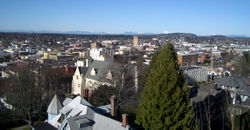 |
|||
|
|||
| Nickname(s): City of Subdued Excitement | |||
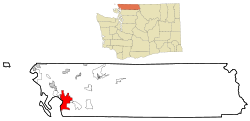 |
|||
| Coordinates: | |||
| Country | United States | ||
| State | Washington | ||
| County | Whatcom | ||
| Incorporated | July 29, 1904 | ||
| Government | |||
| - Type | Mayor–council | ||
| - Mayor | Dan Pike | ||
| Area | |||
| - City | 31.7 sq mi (82.2 km2) | ||
| - Land | 25.6 sq mi (66.4 km2) | ||
| - Water | 6.1 sq mi (15.8 km2) | ||
| Elevation | 69 ft (22 m) | ||
| Population (July 1, 2009) | |||
| - City | 80,055 | ||
| - Density | 2,619.8/sq mi (1,011.5/km2) | ||
| - Metro | 200,434 | ||
| [1] | |||
| Time zone | PST (UTC-8) | ||
| - Summer (DST) | PDT (UTC-7) | ||
| ZIP codes | 98225-98229 | ||
| Area code(s) | 360 | ||
| FIPS code | 53-05280[2] | ||
| GNIS feature ID | 1512001[3] | ||
| Demonym | Bellinghamster | ||
| Website | www.cob.org | ||
Bellingham (pronounced /ˈbɛlɪŋhæm/, us dict: bĕl′·ĭng·hăm) is the largest city in, and the county seat of, Whatcom County in the U.S. state of Washington,[4] and the twelfth largest city in the state. It is situated on Bellingham Bay, which is protected by Lummi Island, Portage Island, and the Lummi Peninsula, and opens onto the Strait of Georgia. It lies west of Mount Baker and Lake Whatcom (from which it gets its drinking water) and north of the Chuckanut Mountains and Skagit Valley. Whatcom Creek runs through the center of the city.
The Census Bureau estimated that Bellingham's population was 80,055 in July 1, 2009.[5] The boundaries of the city encompass the former towns of Fairhaven (now home to the southern ferry terminus of the Alaska Marine Highway System), Whatcom, Sehome, and Silver Beach. Nearly half of all residents of Whatcom County live within Bellingham.
Contents |
History
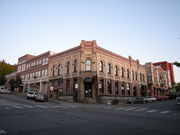
The name of Bellingham is derived from the bay on which the city is situated. George Vancouver, who visited the area in June 1792, named the bay for Sir William Bellingham, the controller of the storekeeper's account of the Royal Navy.[6]
The first caucasian settlers reached the area in 1854. In 1858, the Fraser Canyon Gold Rush caused thousands of miners, storekeepers, and scalawags to head north from California. Whatcom grew overnight from a small northwest mill town to a bustling seaport, the basetown for the Whatcom Trail, which led to the Fraser Canyon goldfields, used in open defiance of colonial Governor James Douglas's edict that all entry to the gold colony be made via Victoria, British Columbia.
Coal mining occurred in the Bellingham area from the mid 19th–mid 20th centuries. Coal was originally discovered by Henry Roeder off the northeastern shore of Bellingham Bay. In 1854, a group of San Francisco investors established Bellingham Bay Coal Company. The mine extended to hundreds of miles of tunnels as deep as 1200'. It ran southwest to Bellingham Bay, on both sides of Squalicum Creek, an area of about one square mile. It employed some 250 miners digging over 200,000 tons of coal annually, at its peak in the 1920s. It was closed in 1955.[7][8][9]
Bellingham was officially incorporated on November 4, 1903 as a result of the incremental consolidation of four towns initially situated around Bellingham Bay during the final decades of the 19th Century. Whatcom is today's "Old Town" area and was founded in 1852.[10] Sehome was an area downtown founded in 1854. Bellingham was further south near Boulevard Park, founded in 1853; while Fairhaven was a large commercial district with its own harbor, also founded in 1853.
In 1890, Fairhaven developers bought Bellingham. Whatcom and Sehome had adjacent borders and both towns wanted to merge; thus they formed New Whatcom. Later on October 27, 1903, the word "New" was dropped from the name, because the Washington State legislature outlawed the word "NEW" from city names, making it into simply "Whatcom". If you look, there are no towns in Washington with a name that starts with "NEW". At first, attempts to combine Fairhaven and Whatcom failed, and there was controversy over the name of the proposed new city. Whatcom citizens wouldn't support a city named "Fairhaven", and Fairhaven residents wouldn't support a city named "Whatcom". They eventually decided to use the name "Bellingham", which remains today. Voting a second time for a final merger of the four towns into a single city, the resolution passed by 2163 votes "for" and 596 "against".[11] Only men were allowed to vote during that era before American woman's suffrage.
In the early 1890s, three railroad lines arrived, connecting the bay cities to a nationwide market of builders. The foothills around Bellingham were clearcut after the 1906 San Francisco earthquake to help provide the lumber for the rebuilding of San Francisco. In time, lumber and shingle mills sprang up all over the county to accommodate the byproduct of their work.
In 1889, Pierre Cornwall and an association of investors formed the Bellingham Bay Improvement Company (BBIC). The BBIC invested in several diverse enterprises such as shipping, coal, mining, railroad construction, real estate sales and utilities. Even though their dreams of turning Bellingham into a Pacific Northwest metropolis never came to fruition, the BBIC made an immense contribution to the economic development of Bellingham.[12]
BBIC was not the only outside firm with an interest in Bellingham utilities. The General Electric Company of New York purchased Bellingham's Fairhaven Line and New Whatcom street rail line in 1897. In 1898 the utility merged into the Northern Railway and Improvement Company which prompted the Electric Corporation of Boston to purchase a large block of shares.[13]
Bellingham's proximity to the Strait of Juan de Fuca and to the Inside Passage to Alaska helped keep some cannery operations here. P.A.F., for example, shipped empty cans to Alaska, where they were packed with fish and shipped back for storage.


Economy
The mean annual salary of a wage earner in Bellingham is $37,990,[14] which is below the Washington State average of $44,710.[15]
Adjusted for inflation, wages in Bellingham and Whatcom County have been declining for more than 30 years as service-oriented jobs gain prominence in the local economy, and goods production (mining, construction and manufacturing) decline as a share of total employment. Service oriented jobs now constitute at least 77% of all non-agricultural employment in Whatcom County.[16]
Between 1989 and 1999 median household income grew 41% in Whatcom County while housing costs grew 108% over the same period. In each year 1998–2000 the average wage in Whatcom County was not enough to afford a two-bedroom rental unit.[17]
For the year 2005, the median price of all homes sold in Whatcom County was $259,000 while the median price of homes sold in the Bellingham area was $269,000. This compares with a statewide median home price of $260,900.[18]
Geography
The city is located at (48.75, -122.48).[19] According to the United States Census Bureau, the city has a total area of 31.7 square miles (82 km2), of which 25.6 square miles (66 km2) is land and 6.1 square miles (16 km2) (19.2%) is water. The lowest elevations are at sea level along the waterfront. Alabama Hill is one of the higher points in the city at about 500 feet. Elevations of 800 feet are found near Yew Street Hill north of Lake Padden and near Galbraith Mountain. Beyond the city limits of Bellingham many taller foothills and small mountains rise in Whatcom County, until climbing to a peak elevation of 10,778 feet at the summit of Mount Baker which is just over 31 miles from the seashore. Mount Baker is the largest volcano in the local area, and its glaciers are visible from many parts of the city. Lake Whatcom forms part of the eastern boundary of the city, while many smaller lakes and wetland areas are found around the region. Bellingham is also about 50 miles south of Vancouver.
Surrounding communities
 |
Ferndale | Laurel | Deming |  |
| Lummi Island | Acme | |||
| Bow |
Demographics
| Historical populations | |||
|---|---|---|---|
| Census | Pop. | %± | |
| 1890 | 8,135 |
|
|
| 1900 | 11,062 | 36.0% | |
| 1910 | 24,298 | 119.7% | |
| 1920 | 25,585 | 5.3% | |
| 1930 | 30,823 | 20.5% | |
| 1940 | 29,314 | −4.9% | |
| 1950 | 34,112 | 16.4% | |
| 1960 | 34,688 | 1.7% | |
| 1970 | 39,375 | 13.5% | |
| 1980 | 45,794 | 16.3% | |
| 1990 | 52,179 | 13.9% | |
| 2000 | 67,171 | 28.7% | |
| Est. 2009 | 80,055 | 19.2% | |
As of the census[2] of 2000, there were 67,171 people, 27,999 households, and 13,999 families residing in the city. The population density was 2,619.3 people per square mile (1,011.5/km2). There were 29,474 housing units at an average density of 1,149.3/sq mi (443.8/km2). The racial makeup of the city was 87.88% White, 0.98% Black or African American, 1.48% Native American, 4.25% Asian, 0.17% Pacific Islander, 2.16% from other races, and 3.08% from two or more races. 4.63% of the population is Hispanic or Latino of any race.
There were 27,999 households out of which 23.1% had children under the age of 18 living with them, 37.5% were married couples living together, 9.2% had a female householder with no husband present, and 50.0% were non-families. 33.0% of all households were made up of individuals and 10.3% had someone living alone who was 65 years of age or older. The average household size was 2.24 and the average familyunder the age of 18, 23.8% from 18 to 24, 26.5% from 25 to 44, 19.6% from 45 to 64, and 12.4% who were 65 years of age or older. The median age was 30 years. For every 100 females there were 92.6 males. For every 100 females age 18 and over, there were 90.6 males.
The median income for a household in the city was $32,530, and the median income for a family was $47,196. Males had a median income of $35,288 versus $25,971 for females. The per capita income for the city was $19,483. About 9.4% of families and 20.6% of the population were below the poverty line, including 17.2% of those under age 18 and 9.0% of those age 65 or over.
See the urban populations at the right.
Climate
Bellingham's climate is generally mild, often referred to as "The Banana Belt of the NorthWest." The average yearly high and low temperatures are 59 °F (15 °C) and 44.1 °F (6.7 °C), respectively. Although the rainy season can last as long as eight months or more, it is usually about six months long, leaving Bellingham with a picturesque late spring and mild, pleasant summer. Although Bellingham receives an average annual rainfall of 34.84 inches (885 mm), many long weeks of short and cloudy days are commonplace in winter.
Western Whatcom County has a damp marine climate (oceanic) and averages 3.9 inches of rain per month from October through April[20].
Summers are quite dry however. Bellingham sees an average of 5.7 rainy days in July and August combined. For comparison, Phoenix, Arizona averages 10 rainy days during the same period. Drought is rare, although some summers are considerably drier than others and some normally reliable wells have been known to run dry in August and September. Nevertheless, crops are more frequently ruined by too much rain than too little.
Bellingham's location and geography occasionally subject it to an unusual and harsh weather pattern wherein an upper level trough drives down cold Arctic air from the Canadian interior, usually through the Fraser River Canyon. This cold air mass can collide with a Gulf of Alaska cold front and create high winds, ice, snow, or heavy rains. A "Silver Thaw" can result and wind chill equivalents can slide well under 0 °F (−18 °C). Such an event was recorded on November 28, 2006. Outside air temperatures of 12 °F (−11 °C) were accompanied by 30 to 48 miles per hour (48 to 77 km/h) winds. Wind chill equivalents reached −10 °F (−23 °C) according to NOAA.[21] On February 1, 1989, the high temperature for the day was 8 °F and the average northeast wind approached tropical storm force at 39 mph average with gusts to 64 mph.[22] Oldtimers also like to talk about January 1950 when the minimum temperature was in the single digits for almost the entire month,[23] but the weather records are incomplete that far back.
Another weather phenomenon, known as the "Chinook wind", happens in the autumn. For most of a day, an unusually warm and steady wind comes out of the south. It is essentially a reverse northeaster. (Some film of a northeaster and a "Chinook" can be seen at this link:[24].) Chinook winds are at their most dramatic in December or January when they follow several days of north east wind. A Chinook wind following a northeast wind can melt significant snow accumulations very quickly, pushing drainage systems to their limits.
The hottest official temperature is 96 °F (36 °C), set on July 29, 2009, beating the old record of 94 °F (34 °C) by 2°F.
| Climate data for Bellingham, Washington | |||||||||||||
|---|---|---|---|---|---|---|---|---|---|---|---|---|---|
| Month | Jan | Feb | Mar | Apr | May | Jun | Jul | Aug | Sep | Oct | Nov | Dec | Year |
| Source: The Weather Channel [25] | |||||||||||||
Education
Bellingham is home to several educational institutions, including Whatcom Community College;[26] Bellingham Technical College;[27] Northwest Indian College;[28] a satellite campus of Trinity Western University; and (with over fifteen thousand students) Western Washington University, which includes, among others Fairhaven College;[29] Huxley college;[30] and the Woodring College of Education[31].
There are three public high schools in the city: Bellingham High School, Sehome High School and Squalicum High School.[32] The city also normally has four middle schools, though the students of Whatcom Middle School have been dispersed to Fairhaven, Kulshan and Shucksan Middle Schools since the building was damaged following a 2010 fire.
For-profit schools include Evergreen Team Concepts[33] and Lean Leadership Institute.
Government
Bellingham has a non-partisan strong-mayor, weak-council form of government. The directly elected mayor serves a four-year term. Six of the seven city council members are elected by ward for staggered four-year terms. The seventh council member is elected at-large every two years.
A municipal court judge is also elected for four year terms.
The city maintains its own municipal police and fire department and operates countywide Medic One service through an agreement with Whatcom County.
Local culture
Events
- The Ski to Sea race[34] is a team relay race made up of seven legs: cross country skiing, downhill skiing (or snowboarding), running, road biking, canoeing (2 person), mountain biking, and kayaking. The racers begin at the Mount Baker Ski Area and make their way down to the finish line on Bellingham Bay. Organized by the Bellingham/Whatcom Chamber of Commerce & Industry, the event was first held in 1973 and traces it roots to the 1911 Mt. Baker Marathon.
- The Bellingham Highland Games & Scottish Festival is held every year at Ferndale’s Hovander Park the first full weekend in June. The outdoor event celebrates Scottish culture and heritage, with two days of games, spectator sports, dancing, music and food.[35]
- Whatcom Community College and Whatcom Human Rights Taskforce host the annual Dr. Martin Luther King Jr. Human Rights Conference on MLK weekend every January. Event workshops, guest speakers, a silent auction and food address the general theme of Human Rights as expressed in the teachings of Dr. King. This event has been held since 1998[36] [37].
- LinuxFest Northwest[38] is a free conference dedicated to discussion and development of the Linux operating system and other open source and free software projects. Held at Bellingham Technical College during the last weekend in April, it draws nearly a thousand computer professionals and enthusiasts from across the northwestern U.S. and western Canada. Since the first conference in 2000 it has become one of the largest events of its kind.
- The annual International Day of Peace is celebrated in Bellingham on 21 September. The holiday was instituted by the United Nations as a 24-hour global cease-fire. The Bellingham-based Whatcom Peace & Justice Center publishes a calendar[39] of upcoming activist events with a theme of non-violence, community dissent, and worldwide Peace.
- The Bellingham Festival of Music[40] is an annual celebration of orchestral and chamber concerts, held in July, hosting musicians from North American orchestral ensembles.
- Bellingham Pride is a parade and festival held in July each year to celebrate LGBT people and their friends. The parade takes place on a midsummer weekend, passing through the downtown and ending in the public market area.[41]
- The Bellingham Wig Out, held each year the Friday before Memorial Day, is a celebration of fun and irreverent welcoming Spring. Events include the Wig Walk, a promenade of Wig wearers through the downtown business district, a Wig Competition, complete with categories from Wee Wigster to the Best Handmade Wig, and a Wig Out Party held at various locations that evening. The Wig Out folks also participate the next day in the Ski to Sea Parade.[42]
- The Imperial Sovereign Court of the Evergreen Empire is a draq queen charity organization that has been in Bellingham for more than 30 years. The group raises money for scholarships and other charitable organizations and holds their largest event, Coronation, the second Saturday of January each year. The Bellingham Gay Pageant is held the third Saturday of each September.[43]
Local attractions
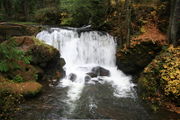
Although Bellingham is smaller than neighboring metropolitan areas such as Seattle, Vancouver, or Victoria, the city and its surrounding region offer many attractions which are popular for both residents and visitors. The Whatcom Museum of History and Art[44] sponsors exhibits of painting, sculpture, local history, and is an active participant in the city's monthly Gallery Walks which are pedestrian tours of the historic buildings of the city, offering history and art lessons for local schools and adult groups, and historic cruises on Bellingham Bay. The Bellingham Railway Museum is where one may find educational displays explaining the history of railroading in Whatcom County, as well as model trains, and a freight-train simulator. The American Museum of Radio and Electricity[45] is a unique local establishment which features a collection of artifacts from 1580 into the 1950s, providing educational resources about the history of electronics and radio broadcasting. The AMRE also operates KMRE-LP 102.3 FM, a low-power FM radio station which broadcasts a number of old shows popular many decades ago, as well as programming of general interest to the local community. Mindport[46] is a privately funded arts and science museum, and is also occasionally involved in the Gallery Walks.
The Bellingham Farmers Market[47] is open on Saturdays from early April thru late December. Originally opened in 1993, the Farmers Market now features more than fifty vendors, music and community events. There is a tradition that "on opening day a cabbage is thrown by a city official to a long standing vendor." The association also operates a weekly Wednesday market in nearby Fairhaven.
The scenic splendour of Bellingham and Whatcom County is appreciated by residents and tourists. Whatcom Falls Park is a 241-acre (0.98 km2) large public park encompassing the Whatcom Creek gorge, running directly through the heart of the city. It has four sets of waterfalls and several miles of walking trails, and is a hub of outdoor activity connecting and defining several different neighborhoods of Bellingham. Popular activities during warmer weather include swimming, fishing, and strolling along the numerous walking trails.[48] About 50 km east of Bellingham the Mount Baker Ski Area is home to many of the world's first snowboarding champions, and it holds the world record for the greatest amount of snowfall in one season (winter 1998–1999). During most years the depth of accumulated snow exceeds 12 ft (3.7 m) and results in the closure of the ski area before the end of the winter months.
South of the city of Bellingham one may travel along Chuckanut Drive (Washington State Route 11), a route which offers cliffside views of the sea, the San Juan Islands, the hills and forests of the Chuckanut mountains, and several small picturesque bays along the edge of the Salish Sea. Several miles from Bellingham in the southern part of Whatcom County there are many places enjoyed by vacationers and enthusiasts of outdoor recreation, including: Larrabee State Park (popular for hiking), Lake Padden (popular for swimming, fishing and golfing), and Lake Samish. To the east of the city lies Lake Whatcom, a beautiful natural resource which provides the local public water supply and is the source of Whatcom Creek. Around Lake Whatcom and the region of Lake Padden there are several large foothills of the Cascades, including North Lookout Mountain, known locally as Galbraith Mountain.
In the waters of the Georgia Strait and Puget Sound it is possible to go whale watching. Several pods of orcas (killer whales) are known to travel from the open Pacific Ocean into the area, and families of these huge aquatic creatures can be seen swimming and hunting near the local bays and islands.
Transportation

The Bellingham International Airport offers regularly scheduled commuter flights to and from Seattle and Friday Harbor, Washington, and regularly scheduled jet service to Las Vegas, Nevada; Reno, Nevada; San Francisco; Phoenix/Mesa, Arizona, and seasonal service to Palm Springs, California. The airport is home of the first Air and Marine Operations Center[49], to assist the US Department of Homeland Security with border surveillance.
Amtrak Cascades provides Bellingham with regularly scheduled passenger rail service to Seattle and Vancouver, British Columbia, Canada. Whatcom Transportation Authority offers regular scheduled bus service throughout the Bellingham area, including service to Mt. Vernon.
The Fairhaven section of the city is the southern terminus of the Alaska Marine Highway. The ferry service offers vehicle and passenger service north to Ketchikan, Alaska and points north including Juneau and Haines.
Music scene
Being located on a major highway, halfway between two major cities, Bellingham has traditionally had a natural advantage of drawing many diverse and highly acclaimed acts to perform at various venues. Also, the presence of a large university-age population has helped Bellingham in that it has been home to a number of regionally and nationally noted musical groups such as Death Cab for Cutie, The Posies, Crayon, Idiot Pilot, Mono Men, Police Teeth, Black Breath,The DT's, Black Eyes and Neckties, The Whiskey Wailers, [50]Federation X, The Trucks,[51] and Shook Ones. Local independent record labels include Estrus Records and Clickpop Records. The town is also home to What's Up! Magazine — a publication devoted to the local music scene for over 10 years.[52]
Bellingham is also the home of an active classical music scene which includes the Whatcom Symphony Orchestra, North Sound Youth Symphony and numerous community music groups and choirs.
Mully Radio at www.mullyradio.com, a radio station for the awareness of local talent, features local artists of the region on its weekly live broadcasts, and provides a constant stream of music from around the area.
Film scene
Bellingham also has a burgeoning independent film community, which is supported by the Whatcom Film Association, a local group of film appreciators with over 1500 members[53] and the Northwest film school ,[54] a hands-on filmmaking program. While not as large-scale or well-financed as some of Seattle's independent film efforts, Bellingham's annual NW Projections Film Festival has grown substantially in attendance since its creation in 1999. Several award-winning short films originated in Bellingham, as well as a handful of feature films.
Literary references
Robert James Waller’s best-selling novel The Bridges of Madison County began with the story of a National Geographic photographer from Bellingham, but Clint Eastwood’s film adaptation omitted this starting point.
Pulitzer Prize-winner Annie Dillard wrote a historical fiction, The Living, set in the American Northwest in the late 19th century and focusing on the settlement at Whatcom on Bellingham Bay.
In Footfall, a bestselling novel by Larry Niven and Jerry Pournelle, Bellingham was mostly destroyed after an alien invasion when Earth's defenders launched an Orion-type vehicle. Bellingham was chosen for this honor after Niven had a bad experience as guest of honor at a local science fiction convention.
Local theater
Bellingham is home to a rich theater culture which is further boosted by the performing arts department at Western Washington University. There are several notable theaters and productions in Bellingham:
- Bellingham Theatre Guild - This non-profit community theater is nearly 80 years old. Hilary Swank performed here before moving to LA to pursue her career in acting.
- Historic Mount Baker Theatre - This beautifully restored theater built in 1927 features a fine example of Moorish architecture and is the largest performing arts facility north of Seattle. The theater is listed on the register of National Historic Places.[55]
- Upfront Theatre,[56] an improv comedy venue established by Bellingham resident Ryan Stiles from Whose Line Is It Anyway? fame.
- Northwest Ballet, a regional ballet company, performs classical ballets like The Firebird, Petrushka and Daphnis et Chloé, as well as annual productions of The Nutcracker.
- iDiOM Theater
- Firehouse Performing Arts Center, a Fairhaven firehouse converted into a dance classroom and theatre, features audience seating descending from the ceiling in a counterweight system and a radiant-heated wood floor. Performances include theatre, music, and dance.
- The high schools of Bellingham School District perform a combined musical production every several years.
Activism
Bellingham is home to the longest-running Peace vigil in the US. Started by Howard and Rosemary Harris more than 46 years ago, it has seen more than 4 generations. On the corner of Magnolia Street and Cornwall, in front of the Federal Building, every Friday starting at 4pm and lasting until usually about 5 pm.[57][58]
International Day of Peace has been observed for the last four years by hundreds of participants. The event commemorates the United Nations' observance of September 21 as a day for international peace and cease-fire. Participants hold a rally at Maritime Heritage Park, and then marched to an event at First Congregational Church.[59][60]
The Whatcom Peace & Justice Center was founded in 2002 by local activists, and has been one of the most active such centers in the nation.[61][62]
Bellingham has a strong chapter of Code Pink,[63] Veterans for Peace,[64] and also a chapter of Iraq Veterans Against the War, Chapter #32.[65]
City Councilman Terry Bornemann has been a staple of the local activist community, and sponsored the October, 2006 Troops Home! resolution, making Bellingham the first city in the state of Washington to pass the resolution.[66]
In July 2008, the Bellingham City Council unanimously passed a resolution urging elected representatives and the federal government to avoid war with Iran, becoming the first city in the state to do so.[67]
Future development
In March 2005, Kiplinger's Personal Finance named Bellingham one of the top retirement cities in the nation.[68] Purchase price of homes has risen and rents have stably risen for the last decade. Many of the condominiums recently built as a result of the demand for affordable housing have subsequently become rental units.
Bellingham has seen a resurgence of real-estate development as house prices climb, caused in part by new residents moving in to the community. In order to accommodate this growth, new properties have sprung up all over the city, including the Downtown, Fairhaven, Happy Valley, Cordata, and Barkley neighborhoods. The city has reiterated their commitment to developing a wide range of housing options for all income categories, while retaining the integrity of existing communities. Annexation of surrounding farmland and county wilderness has been kept to a minimum due to public concern for environmental preservation, but several controversies have risen over the city's decisions to counteract the loss of land by allowing taller buildings in the city core, major new development on previously undeveloped land, and a lack of parks and open spaces in some of the more recently developed areas.
Waterfront redevelopment
The Bellingham waterfront has served as an industrial center for the past century, most notably the area encompassing the former Georgia-Pacific mill. G-P purchased the Puget Sound Pulp and Timber Company in 1963 and operated a pulp mill on the central downtown waterfront until 2001. In 1965, G-P built a Chlor-Alkali facility, which became a source of mercury contamination in the Whatcom Waterway and on the uplands of the site for decades. The documentary film, "Smells Like Money - The Story of Bellingham's Georgia Pacific Plant" tells the story of the site, which has since been purchased by the Port of Bellingham chiefly to create a marina in the 37 acre wastewater lagoon. The Port of Bellingham purchased the G-P site for $10 with the understanding they would assume liability for the contamination. The City of Bellingham and the Port of Bellingham entered into several interlocal agreements in which the City agreed to pay for all infrastructure costs, and the Port would create a marina, clean up the site, and retain all zoning.
The City and Port have entered into a partnership to redevelop the property, which has been unofficially renamed New Whatcom[69] after the township of which the area was originally a part. A general plan for the city's waterfront was developed by the Waterfront Futures Group,[70] and the new Waterfront Advisory Group[71] has been convening to develop a more detailed plan focused on this particular site. The draft plan includes "a new city neighborhood with homes, shops, offices and light industry, as well as parks and promenades, a healthy shoreline habitat along Bellingham Bay..."
Some citizen groups have opposed the Port's plan, most notably the Bellingham Bay Foundation (formed in 2005).[72] During the summer of 2006, the Bellingham Bay Foundation formed People for a Healthy Bay[73] over a concern that many of the areas slated for development contained high mercury levels (as high as 12,500ppm in the soil under the former Chlor-Alkali facility). People for a Healthy Bay launched an initiative that would have required the City of Bellingham to advocate for removal of mercury to the highest practical level. The City successfully sued to keep the initiative off the ballot.
The Washington State Department of Ecology is currently reviewing public comment for the Port's cleanup documents of the Whatcom Waterway.
Ecology will host a second public comment period for the Cleanup Action Plan, at which time the specifics of the cleanup will be discussed and decided. The City of Bellingham and the Port of Bellingham will develop a Master Plan and implement tax-increment financing for the City's portion of funding of infrastructure. Infrastructure alone is expected to cost roughly $200 million. Whatcom County has declined participation in the financing, citing unmet gaps in funding, a lack of benefit to the County, and the need for County taxes to go toward emergency, jail, and mental health services.
Sports
| Club | Sport | League | Stadium | Logo |
|---|---|---|---|---|
| Bellingham Bells | Baseball | West Coast Collegiate Baseball League | Joe Martin Field | |
| Bellingham Slam | Basketball | International Basketball League, West Conference | Whatcom Pavilion | |
| Bellingham Roller Betties | Roller derby | WFTDA | Bellingham Sportsplex | |
| Bellingham Bulldogs[74] | Football | Evergreen Football League (EFL)[75][76] | Civic Field | |
| Chuckanut Bay Geoducks | Rugby Union | Pacific Northwest Rugby Football Union | Bellingham Rugby & Polo Fields | |
| Whatcom Warriors | Youth Ice Hockey | PCAHA & PNAHA | Bellingham Sportsplex |
The people of Bellingham pursue a diverse range of amateur sports, with skiing and snowboarding at the Mount Baker Ski Area popular in the winter and kayaking and cycling in the summer. Mt. Baker claims an unofficial world record for seasonal snowfall, with 1,140 inches (29,000 mm) recorded in the 1998–1999 season.[77]
Western Washington University, located in Bellingham, is home to NCAA Division II National Women's Rowing Champions. Although always nationally ranked, the Lady Vikings, in 2005, became Western's very first NCAA champion team and won again in 2006, 2007, 2008, and 2009.
Western Washington University also operates a successful collegiate road cycling program that took top-5 positions nationwide at the 2006 nationals.[78]
Future Hall of Famer Ken Griffey Jr. began his professional career with the Bellingham Mariners. He played in the Northwest League on the team based in Bellingham.[79]
Media
Newspapers
The Bellingham Herald is published daily in Bellingham. Other newspapers include The Cascadia Weekly,[80] The Western Front,[81] Whatcom Watch,[82] the AS Review,[83] and The Bellingham Business Journal.[84]
Television
Bellingham and Whatcom County are part of the Seattle television market.
- KVOS is an independent television station licensed in Bellingham. The station broadcasts on channel 12. KVOS also enjoys significant viewership from neighboring Metro Vancouver and Victoria.
- KBCB is a ShopNBC television station licensed in Bellingham. The station broadcasts on channel 24.
- Bellingham TV Channel 10 (BTV10).[85][86]
Magazines
- Frequency The Snowboarder's Journal is an independent snowboarding magazine based in Bellingham, published quarterly.
- What's Up! is a monthly music magazine focused on local music. It covers live shows, band bios and new artist releases.[87]
- The Betty Pages is a monthly publication serving the GLBT and alternative lifestyle communities.[88]
AM radio
| Frequency (kHz) | Call Sign | kW (day) | kW (night) | Owner |
|---|---|---|---|---|
| 790 | KGMI | 5 | 1 | Saga Communications |
| 930 | KBAI | 1 | 0.5 | Saga Communications |
| 1170 | KPUG | 10 | 5 | Saga Communications |
FM radio
| Frequency (mHz) | Call Sign | kW | Owner |
|---|---|---|---|
| 89.3 | KUGS | 0.1 | Western Washington University |
| 91.7 | KZAZ | 0.12 | Washington State University |
| 92.9 | KISM | 50 | Saga Communications |
| 102.3 | KMRE-LP | 0.1 | American Museum of Radio and Electricity |
| 104.1 | KAFE | 60 | Saga Communications |
Notable people
- Ben Gibbard – lead singer for Death Cab for Cutie.
- Ryan Stiles – Emmy Award-nominated actor and comedian.
- Hilary Swank – multiple Academy Award-winning actress.
- Jason McGerr - drummer for Death Cab for Cutie.
- Billy Burke – Television and Motion Picture Actor.
- Dana Lyons - Folk and alternative rock musician, author, and environmentalist.
Sister cities
Bellingham maintains sister city relationships with five Pacific Rim port cities.[89][90]
 Tateyama, Chiba, Japan – Since 1958
Tateyama, Chiba, Japan – Since 1958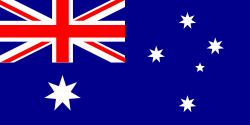 Port Stephens, New South Wales, Australia – Since 1982
Port Stephens, New South Wales, Australia – Since 1982 Nakhodka, Russia – Since 1989
Nakhodka, Russia – Since 1989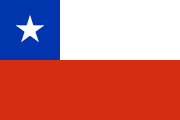 Punta Arenas, Chile – Since 1996
Punta Arenas, Chile – Since 1996 Cheongju, South Korea – Since 2008
Cheongju, South Korea – Since 2008
Bellingham Sister Cities Association is very active in promoting Bellingham's sister city relationships and is very well supported by the community. The relationship with Tateyama, the oldest relationship (which celebrated its 50th year in 2008), is the most active and includes regular events such as an annual city hall staff exchange and community cultural visits. Tateyama frequently fields a team for the Ski to Sea race, or at minimum has representation in the Ski to Sea parade.
Notes
- ↑ "Subcounty population estimates: Washington 2000–2006" (CSV). United States Census Bureau, Population Division. 2007-06-28. http://www.census.gov/popest/cities/files/SUB-EST2006_53.csv. Retrieved 2009-02-01.
- ↑ 2.0 2.1 "American FactFinder". United States Census Bureau. http://factfinder.census.gov. Retrieved 2008-01-31.
- ↑ "US Board on Geographic Names". United States Geological Survey. 2007-10-25. http://geonames.usgs.gov. Retrieved 2008-01-31.
- ↑ "Find a County". National Association of Counties. http://www.naco.org/Template.cfm?Section=Find_a_County&Template=/cffiles/counties/usamap.cfm. Retrieved 2008-01-31.
- ↑ "State and County Quickfacts". U.S. Census Bureau. http://quickfacts.census.gov/qfd/states/53/5305280.html. Retrieved 2006-11-10.
- ↑ Hitchman, Robert (1985). Place Names of Washington. Washington State Historical Society. pp. 18. ISBN 0-917048-57-1.
- ↑ Southcott, Bonnie Hart (2003-10-20). "Mines faced disasters, financial woes". The Bellingham Herald. http://www.bellinghamherald.com/special-pub/centennial/160479.shtml. Retrieved 2008-03-10
- ↑ Stark, John (2008-03-02). "Beneath the city of Bellingham lie the memories of the mines" (– Scholar search). The Bellingham Herald. http://www.bellinghamherald.com/513/story/336698.html. Retrieved 2008-03-10
- ↑ Burkhart, Brendan (2003). "Postcards and Dead Fish: The Capitalism and the Construction of Place, Bellingham, Washington, 1918–1927". Occasional Papers (Center for Pacific Northwest Studies). http://www.acadweb.wwu.edu/CPNWS/occasionalpapers/postcardsandfish/titlepage.htm. Retrieved 2008-03-10. The coal mines are described in 1 - "Introduction" and 5 - "Claiming the Nature of Place".
- ↑ http://www.bellingham-subdued-excitement.com/history-of-bellingham.html
- ↑ http://www.bellinghamherald.com/510/story/228931.html
- ↑ Library Of Congress Engineering Record
- ↑ Library Of Congress
- ↑ "Bellingham, WA - May 2007 Metropolitan and Nonmetropolitan Area Occupational Employment and Wage Estimates". U.S. Department of Labor: Bureau of Labor Statistics. http://www.bls.gov/oes/current/oes_13380.htm. Retrieved 2008-06-20.
- ↑ Washington - May 2007 OES State Occupational Employment and Wage Estimates
- ↑ "Chapter Seven - Economics" (PDF). Whatcom County Comprehensive Plan; January 2005. Planning Services Division, Whatcom County. http://www.co.whatcom.wa.us/pds/planning/comp_plan/2005/2005%20January%20Comp%20Plan%20-%20.pdf%20with%20.jpg%20maps/k%20Chapter%207%20-%20Economics/Chapter%207-Economics.pdf. Retrieved 2008-06-20.
- ↑ "Chapter Three - Housing" (PDF). Whatcom County Comprehensive Plan; January 2005. Planning Services Division, Whatcom County. http://www.co.whatcom.wa.us/pds/planning/comp_plan/2005/2005%20January%20Comp%20Plan%20-%20.pdf%20with%20.jpg%20maps/g%20Chapter%203%20-%20Housing/Chapter%203-Housing.pdf. Retrieved 2008-06-20.
- ↑ "Whatcom County Real Estate Research Report". Washington State University College of Business; Washington Center for Real Estate Research. 2007. http://www.wcrer.wsu.edu/Whatcom/Whatcom2006.htm. Retrieved 2008-06-20.
- ↑ "US Gazetteer files: 2000 and 1990". United States Census Bureau. 2005-05-03. http://www.census.gov/geo/www/gazetteer/gazette.html. Retrieved 2008-01-31.
- ↑ "Federal Research Division of the Library of Congress". http://countrystudies.us/united-states/weather/washington/bellingham.htm.
- ↑ Extensive historical weather data for Bellingham can be found at http://www.weatherbase.com/weather/weather.php3?s=61737&refer= Weatherbase.com.
- ↑ See http://www.wunderground.com/history/airport/KBLI/1989/1/29/WeeklyHistory.html
- ↑ See http://www.wunderground.com/history/airport/KBLI/1950/1/1/MonthlyHistory.html?req_city=NA&req_state=NA&req_statename=NA
- ↑ http://video.google.com/videoplay?docid=-338551545867783342
- ↑ "Average Weather for Bellingham, WA - Temperature and Precipitation". http://www.weather.com/weather/wxclimatology/monthly/graph/USWA0028. Retrieved 2010 February 13.
- ↑ Whatcom Community College, Bellingham, Washington
- ↑ Bellingham Technical College
- ↑ [1]
- ↑ Fairhaven College of Interdisciplinary Studies
- ↑ Huxley College Home Page
- ↑ Woodring College of Education
- ↑ http://www.bham.wednet.edu/schools/schools.htm
- ↑ Evergreen Team Concepts
- ↑ http://www.bellingham.com/skitosea/
- ↑ www.bhga.org
- ↑ http://www.whatcom.ctc.edu/content/EventsItem_336_v?PHPSESSID=5ffc868735e3a811c64d45c916c64cfd
- ↑ http://www.whrtf.org/index.shtml
- ↑ LinuxFest Northwest 2008
- ↑ WJPC Calendar
- ↑ Bellingham Festival of Music Homepage
- ↑ Bellingham Pride MySpace profile
- ↑ http://www.thewigout.com
- ↑ http://www.evergreenempire.org
- ↑ Whatcom Museum of History and Art
- ↑ American Museum of Radio - Home
- ↑ M I N D P O R T - A Hands-on museum of science and art in Bellingham Washington
- ↑ Bellingham Farmers Market
- ↑ Bellingham, WA: Whatcom Falls Park
- ↑ ICE launches first northern border Air Marine Branch - CBP.gov
- ↑ "The Whiskey Wailers". http://www.myspace.com/thewhiskeywailers. Retrieved 2009-11-17. This is the web site for The Whiskey Wailers band. This band is native to Bellingham as listed on their homepage.
- ↑ "The Trucks". http://www.thetrucks.net. Retrieved 2006-12-21. This is the web site for The Trucks band. The "Shows" page lists many gigs in Bellingham.
- ↑ "What's Up Magazine". http://www.whatsup-magazine.com/. Retrieved 2009-01-15.
- ↑ Whatcom Film Association
- ↑ Welcome to the Northwest Film School
- ↑ Mount Baker Theatre
- ↑ The Up Front Theatre
- ↑ http://www.bellinghampeace.org/
- ↑ Friday Peace Demos (2007) - The NW Fellowship of Reconciliation Meet Up Group (Seattle, WA) - Meetup.com
- ↑ United for Peace & Justice: Events
- ↑ Bellingham, Whatcom County Local News | Bellingham Herald
- ↑ http://www.bellinghampeace.org/press/02_12center.html
- ↑ Whatcom Peace & Justice Center | October 27
- ↑ CodePINK Bellingham
- ↑ Western Washington Veterans For Peace Chapter 92 - Greater Seattle Area
- ↑ Bellingham WA | Chapter 32 | Iraq Veterans Against the War
- ↑ Council Minutes for September 25, 2006 City of Bellingham, WA
- ↑ http://www.citiesforprogress.org/index.php?option=com_content&task=view&id=726&Itemid=1
- ↑ Esswein, Pat Mertz; Franklin, Mary Beth; Rheault, Magali. "12 Great Places to Retire". Kiplinger.com. http://www.kiplinger.com/features/archives/2005/03/12places.html. Retrieved 2006-11-10.
- ↑ Home - New Whatcom Master Plan
- ↑ Connecting Bellingham to the Bay: Welcome to Waterfront Futures
- ↑ http://www.cob.org/mayor/boards_commissions/waterfront/waterfront.htm
- ↑ Bellingham Bay Foundation
- ↑ Cleanup Comes First!
- ↑ Bellingham Bulldogs (2008). "Bellingham Bulldogs Semi-Pro Football". http://www.bellinghambulldogs.com/. Retrieved 2008-03-19. Team's official website.
- ↑ Bellingham Bulldogs (2008). "The EFL". http://www.bellinghambulldogs.com/leagueinformation.html. Retrieved 2008-03-19. League information on team's official website.
- ↑ Evergreen Football League (2008). "Evergreen Football League, Real Men, Real Football". http://www.evergreenfootballleague.com. Retrieved 2008-03-19. League's official website.
- ↑ "Climate-Watch, May 1999". National Oceanic and Atmospheric Administration. http://www.ncdc.noaa.gov/oa/climate/extremes/1999/may/extremes0599.html. Retrieved 2006-11-10.
- ↑ WWU Cycling Home
- ↑ http://sports.jrank.org/pages/1809/Griffey-Ken-Jr-Picked-No-1-in-Baseball-Draft.html
- ↑ :: Cascadia Weekly:: Reporting from the heart of Cascadia::
- ↑ The Western Front - Front Page
- ↑ Whatcom Watch Online - Home Page
- ↑ AS Review
- ↑ The Bellingham Business Journal
- ↑ Bellingham TV Channel 10 - City of Bellingham, WA
- ↑ Error - LexisNexis Publisher
- ↑ What's Up! Magazine - Bellingham, Washington's local music scene
- ↑ [2]
- ↑ "Bellingham Sister Cities". Bellingham Sister Cities Association. http://www.bsca.org/. Retrieved 2008-06-22.
- ↑ "Online Directory: Washington, USA". Sister Cities International. http://www.sister-cities.org/icrc/directory/usa/WA. Retrieved 2008-06-22.
References
- http://sports.jrank.org/pages/1809/Griffey-Ken-Jr-Picked-No-1-in-Baseball-Draft.html
- http://www.uscollegesearch.org/bellingham-washington-colleges.html
- http://www.bham.wednet.edu/schools/schools.htm
Further reading
Historical
- MacGibbon, Elma (1904). "Bellingham and Everett" (DJVU). Leaves of knowledge. Washington State Library's Classics in Washington History collection. Shaw & Borden. OCLC 61326250. http://www.secstate.wa.gov/history/publications%5Fdetail.aspx?p=63.
External links
- City of Bellingham Website
- Bellingham-Whatcom Chamber of Commerce & Industry
- Downtown Bellingham Renaissance Network
- Whatcom County Historical Society and Whatcom County History
- Bellingham, Washington at the Open Directory Project
|
|||||||||||||||||||||||||||||||||||
|
|||||||||||||||||
|
||||||||||||||||||||

